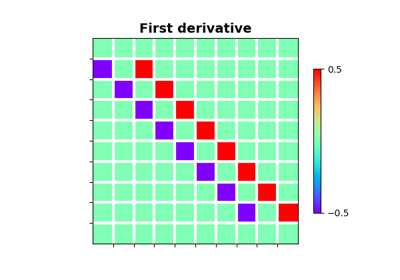pylops.Gradient#
- class pylops.Gradient(dims, sampling=1, edge=False, kind='centered', dtype='float64', name='G')[source]#
Gradient.
Apply gradient operator to a multi-dimensional array.
Note
At least 2 dimensions are required, use
pylops.FirstDerivativefor 1d arrays.- Parameters
- dims
tuple Number of samples for each dimension.
- sampling
tuple, optional Sampling steps for each direction.
- edge
bool, optional Use reduced order derivative at edges (
True) or ignore them (False).- kind
str, optional Derivative kind (
forward,centered, orbackward).- dtype
str, optional Type of elements in input array.
- dims
Notes
The Gradient operator applies a first-order derivative to each dimension of a multi-dimensional array in forward mode.
For simplicity, given a three dimensional array, the Gradient in forward mode using a centered stencil can be expressed as:
\[\mathbf{g}_{i, j, k} = (f_{i+1, j, k} - f_{i-1, j, k}) / d_1 \mathbf{i_1} + (f_{i, j+1, k} - f_{i, j-1, k}) / d_2 \mathbf{i_2} + (f_{i, j, k+1} - f_{i, j, k-1}) / d_3 \mathbf{i_3}\]which is discretized as follows:
\[\begin{split}\mathbf{g} = \begin{bmatrix} \mathbf{df_1} \\ \mathbf{df_2} \\ \mathbf{df_3} \end{bmatrix}\end{split}\]In adjoint mode, the adjoints of the first derivatives along different axes are instead summed together.
Methods
__init__(dims[, sampling, edge, kind, ...])adjoint()apply_columns(cols)Apply subset of columns of operator
cond([uselobpcg])Condition number of linear operator.
conj()Complex conjugate operator
div(y[, niter, densesolver])Solve the linear problem \(\mathbf{y}=\mathbf{A}\mathbf{x}\).
dot(x)Matrix-matrix or matrix-vector multiplication.
eigs([neigs, symmetric, niter, uselobpcg])Most significant eigenvalues of linear operator.
matmat(X)Matrix-matrix multiplication.
matvec(x)Matrix-vector multiplication.
reset_count()Reset counters
rmatmat(X)Matrix-matrix multiplication.
rmatvec(x)Adjoint matrix-vector multiplication.
todense([backend])Return dense matrix.
toimag([forw, adj])Imag operator
toreal([forw, adj])Real operator
tosparse()Return sparse matrix.
trace([neval, method, backend])Trace of linear operator.
transpose()
